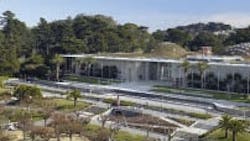Green Building incorporates high-tech engineering
When the California Academy of Sciences opens its new state-of-the-art facility on September 27 in San Francisco's Golden Gate Park, the construction will be the largest public LEED (Leadership in Energy and Environmental Design) platinum building in the world. The Academy houses the Steinhart Aquarium, Morrison Planetarium, and Kimball Natural History Museum. The U.S. Green Building Council measures varying “shades of green” through its LEED rating system, with the highest rating being platinum. The project is one of 10 pilot “green building” projects by the San Francisco Department of the Environment, and is part of an initiative to develop models for workable, sustainable public architecture.
Significant engineering expertise and technology is going into all facets of the new building. For example, skylights in the “living roof” will automatically open and close to vent hot air out through the tops of the domes, while motorized windows will automatically open and shut to let in cool air. Photosensors in the lighting system will automatically dim artificial lights in response to daylight penetration, reducing the energy required to illuminate interior spaces. Sensor-activated bathroom faucets will charge themselves after each use: Flowing water will cause an internal turbine to generate power and charge the battery pack. A solar canopy around the perimeter of the roof contains 60,000 photovoltaic cells that will supply almost 213,000 kWh of clean energy per year and prevent the release of more than 405,000 pounds of greenhouse gas emissions annually. The multi-crystalline solar cells are the most energy efficient photovoltaic devices on the market, achieving at least 20% efficiency.
Further design elements include methods and materials that optimize heat and humidity, make the most of natural light and ventilation, maximize renewable energy sources, and efficiently use water resources and recycled building materials. One of the most dramatic features of the building design is the 2.5-acre living roof, home to 1.7 million native plants selected to provide a habitat for a wide variety of wildlife. The plants, including various berry bushes and flower varieties, are meant to attract native birds, hummingbirds, bumblebees, moths, butterflies, and helpful wasps and pirate bugs that feed on pest insects.
